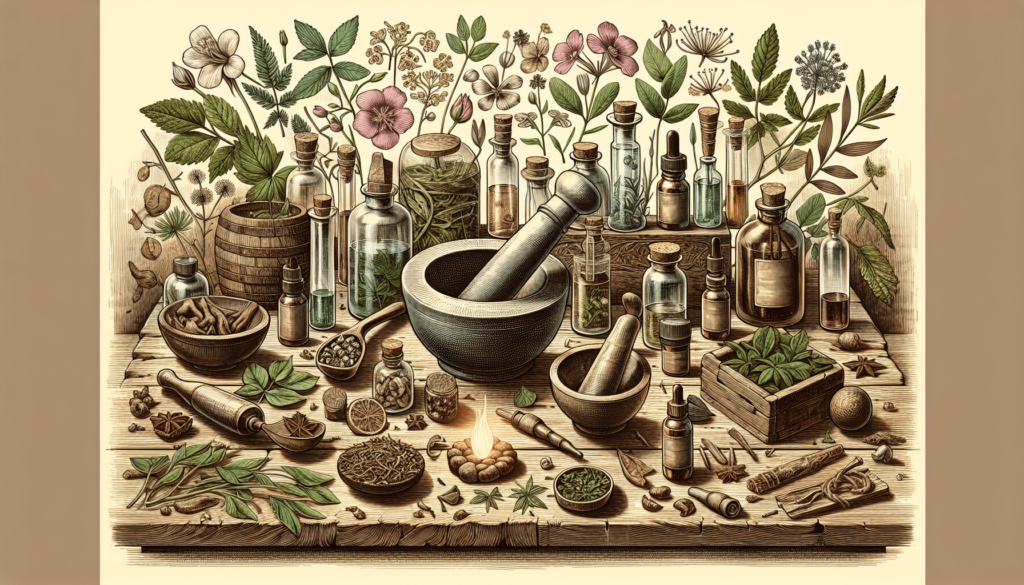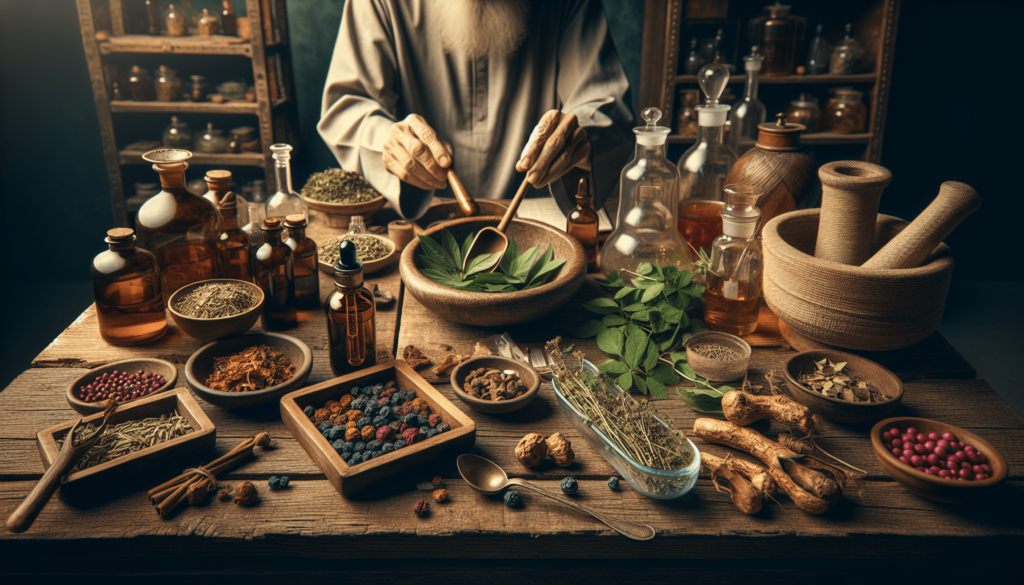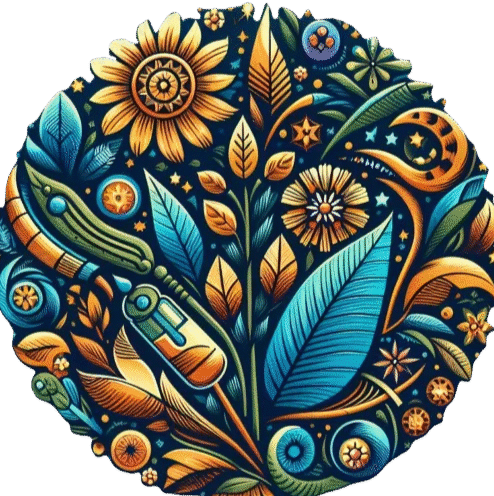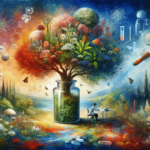So, you’re curious about the art of herbal tinctures, huh? Well, let’s dive right in. Herbal tinctures have been around for centuries, serving as potent remedies and natural healers. From soothing anxiety to improving digestion, these concentrated herbal extracts offer a world of holistic benefits. In this article, we’ll explore the ins and outs of creating your very own tinctures, discussing the different types of herbs to use, the extraction process, and the various ways to incorporate them into your daily routine. So, get ready to embark on a journey into the fascinating world of herbal tinctures and discover the power of nature at your fingertips.
Introduction to Herbal Tinctures
Herbal tinctures are concentrated liquid extracts made from medicinal plants and herbs. They have been used for centuries to harness the therapeutic benefits of these natural substances. In this comprehensive guide, we will explore the definition and basics of herbal tinctures, delve into their rich history, and uncover the wide range of benefits and uses they offer.
Definition and Basics of Herbal Tinctures
Herbal tinctures are alcohol-based extracts that capture the medicinal properties of plants. The alcohol acts as a solvent, extracting and preserving the active compounds from the herbs. Tinctures are known for their high potency and quick absorption, making them an effective way to incorporate herbal remedies into your wellness routine.
To make a tincture, the plant material is typically macerated or soaked in alcohol for several weeks to allow the active compounds to infuse. The resulting liquid extract is then strained and stored in glass jars or bottles, ready for use. Tinctures can be taken orally or applied topically, depending on the intended use.
History of Herbal Tinctures
The use of herbal tinctures dates back to ancient civilizations, where traditional healers and herbalists recognized the power of plants in promoting health and healing. Throughout history, various cultures have documented their own methods and recipes for preparing herbal tinctures, passing down their knowledge from generation to generation.
In Europe, herbal tinctures gained popularity during the Middle Ages, with monastic gardens and apothecaries becoming hubs for herbal medicine production. The tincture-making process was refined over time, with more precise measurements and extraction techniques being developed. Today, herbal tinctures continue to be an integral part of natural health practices and are widely utilized by herbalists and holistic practitioners.

Benefits and Uses of Herbal Tinctures
Herbal tinctures offer a multitude of benefits and can be used to address a wide range of health concerns. The concentrated nature of tinctures allows for maximum effectiveness and potency. Some of the common uses of herbal tinctures include immune support, stress relief, digestive health, and skin healing.
Tinctures can also be tailored to individual needs by combining different herbs to create unique formulas. This customization allows for targeted treatment and can enhance the overall efficacy of herbal remedies. Additionally, herbal tinctures can often be used as a natural alternative to pharmaceutical medications, providing a more holistic approach to health and wellness.
Choosing the Right Herbs
Choosing the right herbs is crucial when creating herbal tinctures. Each herb possesses its own unique properties and benefits, making it important to understand their individual characteristics before selecting which ones to include in your tincture. Here are some key factors to consider:
Understanding Herbal Properties
Before deciding on which herbs to use, it’s essential to familiarize yourself with their properties. Some herbs are known for their calming effects, while others offer immune-boosting properties or support digestive health. By understanding the specific properties of each herb, you can select those that align with your intended use and desired benefits.
Research and Education
Proper research and education are paramount when choosing herbs for tincture-making. It’s important to consult reliable sources, such as reputable herbal books or trained herbalists, to gather information about the herbs you are considering. Understanding the potential interactions, contraindications, and dosage guidelines for each herb will help ensure their safe and effective use.
Quality and Sourcing
The quality of the herbs used in tincture-making is crucial for obtaining desired results. Choose organic, sustainably sourced herbs to ensure they are free from pesticides, herbicides, and other harmful substances. Sourcing herbs from reputable suppliers or growing them yourself can guarantee their freshness and authenticity.
Preparation and Extraction Methods
There are several methods for preparing herbal tinctures, each with its own advantages and considerations. The choice of method will depend on the desired outcome, the properties of the herbs, and personal preference. Here are some common extraction methods:
Alcohol-Based Tinctures
Alcohol-based tinctures are the most common and traditional method of extraction. The alcohol acts as a powerful solvent, effectively extracting the medicinal compounds from the herbs. The high alcohol content also acts as a preservative, prolonging the shelf life of the tincture. The recommended alcohol percentage for tincture-making is typically between 40-60%.
Glycerin-Based Tinctures
Glycerin-based tinctures are a suitable alternative for those who wish to avoid the use of alcohol. Glycerin is a sweet and syrupy liquid that can extract certain plant compounds effectively. However, it is important to note that glycerin may not extract all constituents from the herbs as effectively as alcohol, making it a less potent option. Glycerin-based tinctures are also more prone to spoiling and have a shorter shelf life.
Vinegar-Based Tinctures
Vinegar-based tinctures are another alcohol-free option for those looking to avoid alcohol in their tincture preparations. Vinegar, especially raw and organic apple cider vinegar, can extract certain properties from herbs and act as a preservative. However, vinegar-based tinctures may have a strong taste and are not suitable for all herbs.
Other Solvents and Techniques
In addition to alcohol, glycerin, and vinegar, other solvents and techniques can be used for tincture-making, such as water-based decoctions or oil-based infusions. These methods are more specific to certain herbs and require different extraction techniques. It’s important to research and follow specific instructions for each herb and solvent combination.

Equipment and Supplies
To make herbal tinctures at home, you will need a few essential equipment and supplies to ensure a successful and efficient process. Here are the key items you will require:
Herbs and Plant Material
Choose high-quality and organic herbs for your tinctures. Whether using fresh or dried herbs, make sure they are clean and free from any dirt or debris. The quantity of herbs will depend on your chosen recipe and desired potency.
Alcohol or Solvents
Select a high-proof alcohol, such as vodka or brandy, for alcohol-based tinctures. Ensure the alcohol is of good quality and free from additives or flavorings. If opting for glycerin or vinegar, make sure they are organic and of reputable sources.
Glass Jars or Bottles
Choose dark glass jars or bottles to store your tincture. Amber or cobalt blue glass helps protect the tincture from light damage and preserves its potency. Ensure the jars or bottles are clean and sterilized before use.
Labels and Markers
Proper labeling is essential to keep your tinctures organized and to track their preparation and usage. Use waterproof labels and markers to clearly indicate the herbs used, the solvent type, and the preparation date.
Straining and Filtering Tools
You will need straining and filtering tools, such as cheesecloth or fine-mesh sieves, to remove the plant material from the tincture after extraction. These tools help ensure a smooth and debris-free final product.
Step-by-Step Guide to Making Herbal Tinctures
Making herbal tinctures at home is a simple process that requires careful attention to detail and following specific steps. From choosing the right ratio and strength to properly preparing the herbs, here is a step-by-step guide to help you create your own herbal tinctures:
Choosing the Right Ratio and Strength
The ratio of herbs to solvent is an important consideration when making tinctures. As a general guideline, a 1:5 ratio is commonly used – 1 part herb to 5 parts solvent. However, this can vary depending on the herb and its potency. Adjust the ratio based on the desired strength and the recommendations provided by trusted sources.
Measuring and Calculating Quantities
Accurate measurements are crucial for obtaining consistent and effective tinctures. Weigh the herbs and measure the solvent to ensure the precise ratio. Use a reliable scale and measuring tools to achieve accuracy. Keep track of the quantities used for each tincture batch for future reference.
Herb Preparation: Fresh vs. Dried
The preparation of the herbs will depend on whether you are using fresh or dried plant material. Fresh herbs may require chopping or bruising to release their juices, while dried herbs should be crumbled or powdered for improved extraction. Ensure the herbs are properly processed before adding them to the solvent.
Extraction Process: Maceration vs. Percolation
The extraction process involves soaking the herbs in the chosen solvent to extract their beneficial properties. Maceration is the most common method, where the herbs are left to soak in the solvent for a specific duration. Percolation, on the other hand, involves continuously dripping the solvent through a column of packed herbs. Research and understand the appropriate extraction method for each herb.
Storage and Aging
After the extraction process, strain the tincture to remove any plant material and transfer it to dark glass jars or bottles. Label the containers with the necessary information and store them in a cool, dark place. Allowing the tincture to age for at least 4-6 weeks can enhance its potency and effectiveness.
Herbal Tincture Recipes
Creating your own herbal tinctures opens up a world of possibilities for customized formulations. Here are a few recipes to get you started:
Immune-Boosting Blend
Ingredients:
- Echinacea root (25 grams)
- Elderberry (25 grams)
- Astragalus root (25 grams)
- Vodka or brandy (500 ml)
Instructions:
- Combine the herbs in a glass jar.
- Pour the alcohol over the herbs, making sure they are completely covered.
- Seal the jar tightly and shake well.
- Store the jar in a cool, dark place for 4-6 weeks, shaking it daily.
- After the aging period, strain the tincture and bottle it in dark glass containers.
Stress and Anxiety Relief Formula
Ingredients:
- Lemon balm (50 grams)
- Chamomile flowers (25 grams)
- Passionflower (25 grams)
- Vodka or brandy (500 ml)
Instructions:
- Place the herbs in a glass jar.
- Pour the alcohol over the herbs, ensuring they are fully submerged.
- Seal the jar tightly and shake gently.
- Store it in a cool, dark place for 4-6 weeks, shaking it occasionally.
- Strain the tincture and transfer it to dark glass bottles for storage.
Digestive Aid Mixture
Ingredients:
- Peppermint leaves (50 grams)
- Fennel seeds (25 grams)
- Ginger root (25 grams)
- Vodka or brandy (500 ml)
Instructions:
- Combine the herbs in a glass jar.
- Cover the herbs with the chosen alcohol, ensuring they are completely covered.
- Seal the jar and give it a gentle shake.
- Store in a cool, dark place for 4-6 weeks, shaking it occasionally.
- Strain the tincture and bottle it in dark glass containers.
Skin Healing Solution
Ingredients:
- Calendula flowers (50 grams)
- Plantain leaves (25 grams)
- Lavender flowers (25 grams)
- Vodka or brandy (500 ml)
Instructions:
- Place the herbs in a glass jar.
- Add the alcohol, ensuring the herbs are fully immersed.
- Seal the jar tightly and give it a gentle shake.
- Store in a cool, dark place for 4-6 weeks, shaking it occasionally.
- After the aging period, strain the tincture and transfer it to dark glass bottles for storage.
Safety and Storage Guidelines
While herbal tinctures are generally safe and well-tolerated, it’s important to follow certain guidelines to ensure their safe use:
Dosage and Administration Guidelines
Research proper dosage guidelines for the herbs used in your tincture. It’s advisable to start with a low dosage and gradually increase if needed. Consult a qualified herbalist or healthcare professional if you have any concerns or specific health conditions.
Possible Side Effects and Allergies
Herbal tinctures can sometimes cause adverse reactions or allergies in certain individuals. It’s essential to be aware of the potential side effects and consult a medical professional if you experience any adverse reactions. Additionally, if you have known allergies to specific plants or herbs, avoid using tinctures that contain those ingredients.
Proper Storage and Shelf Life
To preserve the potency and effectiveness of your herbal tinctures, store them in a cool, dark place away from direct sunlight. Properly sealed and labeled dark glass bottles are ideal for storage. The shelf life of tinctures can vary depending on the herbs and the solvent used, but generally, they can last for several years if stored correctly.
Common Herbal Tinctures and Their Uses
While the possibilities for creating herbal tinctures are virtually endless, some herbs have become staples in holistic medicine due to their well-documented benefits. Here are a few common herbal tinctures and their uses:
Chamomile for Relaxation
Chamomile tincture is known for its calming and relaxing properties. It can be used to promote restful sleep, alleviate anxiety, and ease digestive discomfort.
Echinacea for Immune Support
Echinacea tincture is widely used to support the immune system and enhance the body’s defenses against infections and viruses. It can be taken at the onset of an illness or used preventively during cold and flu seasons.
Peppermint for Digestive Health
Peppermint tincture is highly regarded for its digestive benefits. It can help relieve indigestion, soothe stomach discomfort, and alleviate symptoms of irritable bowel syndrome (IBS).
Valerian for Sleep Aid
Valerian tincture is commonly used as a natural sleep aid. It can promote relaxation, improve sleep quality, and help with insomnia or nervous tension.
Combining Herbal Tinctures with Other Natural Remedies
Herbal tinctures can be combined with other natural remedies to enhance their effectiveness and broaden their applications. Here are a few ways to combine herbal tinctures with other remedies:
Herbal Tinctures and Essential Oils
By blending herbal tinctures with essential oils, you can create potent topical remedies. Dilute a few drops of essential oil with a carrier oil, such as coconut or jojoba oil, and add a small amount of the appropriate herbal tincture for a powerful topical application.
Herbal Tinctures and Tea Blends
Combining herbal tinctures with herbal teas allows for a dynamic fusion of benefits. Create your own tea blend by steeping herbal tea leaves or bags in hot water and adding a few drops of your chosen tincture for an extra boost.
Herbal Tinctures and Herbal Salves
Herbal tinctures can be incorporated into homemade salves or balms for topical application. Add a few drops of the desired tincture to a base salve, such as beeswax or shea butter, to create a soothing and healing ointment.
Conclusion
The art of herbal tinctures provides a gateway to natural health and wellness. By understanding the basics of tincture-making, you can unlock the therapeutic potential of medicinal plants and incorporate their benefits into your life. From choosing the right herbs to preparing the tinctures and exploring their various uses, herbal tinctures offer endless possibilities for enhancing your health and well-being. Embrace the art of herbal tinctures and embark on a journey of exploration and experimentation as you nurture your body, mind, and spirit through the power of nature’s remedies.





